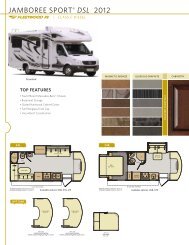Create successful ePaper yourself
Turn your PDF publications into a flip-book with our unique Google optimized e-Paper software.
Using the Engine to Slow<br />
the Motor Home<br />
To use the engine as a braking force, select the<br />
next lower gear . Engine braking provides good<br />
speed control for going down grades . When the<br />
motor home is heavily loaded, towing, or the<br />
grade is steep, preselection of a lower gear prior<br />
to the grade may be desirable .<br />
Gear preselection means the selection of a<br />
lower gear to match the driving conditions you<br />
encounter or expect to encounter . Preselection<br />
will give you better control on slick or icy roads<br />
and on downgrades . Downshifting to lower<br />
gears increases engine braking . The selection<br />
of a lower gear often prevents cycling between<br />
a gear and the next higher gear on a series of<br />
short up-and-down hills .<br />
MANEUVERING IN TRAFFIC<br />
Be cautious when maneuvering to allow for the<br />
length and width of the vehicle . Always allow<br />
room to corner and to change lanes . Your vehicle’s<br />
side view mirrors and rear view camera monitor<br />
(if equipped) will help you keep aware of your<br />
vehicle’s position and the position of other vehicles<br />
and/or obstructions near your motor home . You<br />
must monitor them constantly while you are driving<br />
. Become familiar with the operation of the side<br />
mirrors and learn to use them to view objects and<br />
the road beside and behind the motor home .<br />
The rear view mirrors are controlled from a<br />
panel located on the driver’s left side instrument<br />
panel . Mirrors should be adjusted prior to operation<br />
of your vehicle in traffic. To adjust the mirrors,<br />
select either LEFT or RIGHT mirror and<br />
press the appropriate arrow . Activate the mirror<br />
heaters (if equipped) by pressing the HEATER<br />
position .<br />
Remember that your motor home is heavier than<br />
a car, making it less maneuverable and harder<br />
to stop . Also, because of its greater side surface<br />
area, it is more easily affected by cross winds .<br />
Allow extra distances for passing and stopping .<br />
3<br />
NOTE<br />
On The Road<br />
Although your motor home is equipped with power<br />
steering, the front wheels may be difficult to turn when<br />
at a dead stop. When maneuvering in some close<br />
situations, give yourself some room to move either<br />
forward or backward. The vehicle has to be in motion<br />
for the front wheels to be turned with ease.<br />
Driving on winding or mountain roads is not<br />
difficult if done with reasonable care. Observe<br />
proper vehicle speeds when ascending or<br />
descending hills and always operate in the<br />
proper transmission range . Downshift on hills<br />
to avoid overheating or undue engine loads .<br />
Downshift when descending grades .<br />
Engine compression and friction will help control<br />
vehicle speed, and relieve some of the strain<br />
on the brakes . Shift the transmission to a lower<br />
gear before starting down the grade .<br />
Mountain driving or desert temperatures can put<br />
extreme demands on drive train components .<br />
Under extreme heat conditions you may need to<br />
turn off the vehicle air conditioner to improve<br />
engine and transmission cooling .<br />
Be aware of the extra height of your motor<br />
home . Check for low hanging tree branches<br />
or other obstructions whenever you drive or<br />
park . Avoid low overhangs when pulling in for<br />
service . Always check overhead clearances of<br />
overpasses and bridges . This may be particularly<br />
important if you drive with the overhead<br />
vents open or if the motor home is equipped<br />
with a roof air conditioner, roof rack, CB or<br />
TV/<br />
radio/satellite antenna.<br />
Before leaving on a trip, check your route .<br />
Some tunnels prohibit motor homes with Propane<br />
systems .<br />
When parking parallel to a curb, be sure to<br />
allow for poles or obstructions as the front<br />
and rear portions of the motor home swing<br />
wider than an automobile . When parking on an<br />
incline, turn the front wheels into the curb in<br />
the direction of the roll to aid the parking brake .<br />
When parking, always shift the transmission to<br />
P and set the parking brake .<br />
05-15






